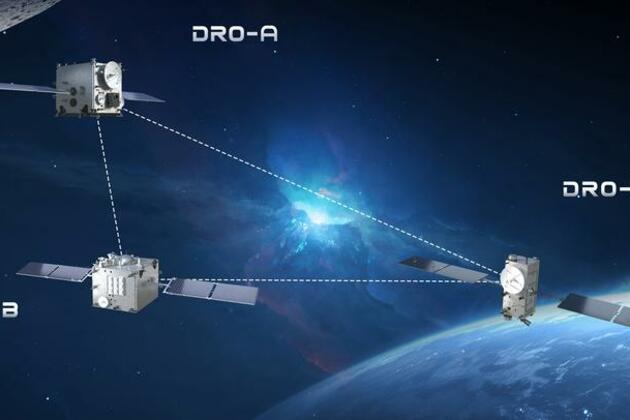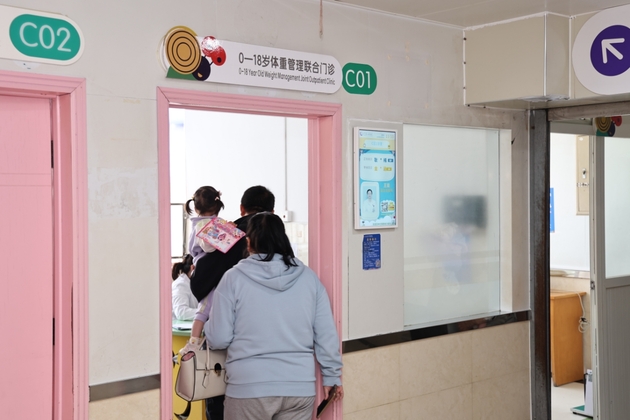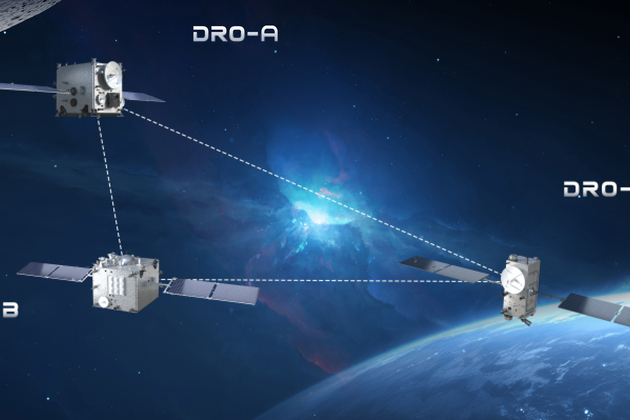China builds three-satellite constellation in Earth-moon space
Xinhua
16 Apr 2025, 07:48 GMT+10

BEIJING, April 16 (Xinhua) -- China has successfully established the world's first three-satellite constellation based on the Distant Retrograde Orbit (DRO) in the Earth-moon space, laying a foundation for the exploration and utilization of space, and for future crewed deep-space exploration.
DRO-A and DRO-B, two satellites developed by the Chinese Academy of Sciences (CAS) and deployed in the DRO, have established inter-satellite measurement and communication links with DRO-L, a previously launched near-Earth orbit satellite. The achievement was disclosed at a symposium on Earth-moon space DRO exploration in Beijing on Tuesday.
DRO is a unique type of orbit, and the Earth-moon space refers to the region extending outward from near-Earth and near-lunar orbits, reaching a distance of up to 2 million kilometers from Earth. In the Earth-moon space, DRO is characterized by a prograde motion around Earth and a retrograde motion around the moon, said Wang Wenbin, a researcher at the CAS' Technology and Engineering Center for Space Utilization (CSU).
Since DRO provides a highly stable orbit where spacecraft require little fuel to enter and stay, it serves as natural space hub connecting Earth, the moon and deep space, offering support for space science exploration, the deployment of space infrastructure, and crewed deep-space missions, Wang said.
On Feb. 3, 2024, the experimental DRO-L satellite was sent into a sun-synchronous orbit and began conducting experiments as planned. The DRO-A/B dual-satellite combination was launched from the Xichang Satellite Launch Center in southwest China's Sichuan Province on March 13, 2024, but failed to enter its intended orbit due to an anomaly in the upper stage of the carrier rocket.
Facing this challenge, the satellite team performed a "life-or-death" rescue operation under extreme conditions, promptly executing multiple emergency orbit maneuvers to correct the trajectory of the two satellites.
After a journey of 8.5 million kilometers, the DRO-A/B dual-satellite combination ultimately reached its designated orbit, according to Zhang Hao, a researcher at CSU who participated in the rescue operation.
On Aug. 28, 2024, the two satellites were successfully separated. Later, both DRO-A and DRO-B established K-band microwave inter-satellite measurement and communication links with DRO-L, testing the networking mode of the three-satellite constellation, Zhang said.
Currently, the DRO-A satellite stays in DRO, while the DRO-B satellite operates in Earth-moon space maneuver orbits, according to CSU.
The satellites ultimately succeeded in entering their designated orbit, demonstrating China's breakthroughs in deep-space fault recovery and autonomous navigation technologies. This achievement highlighted the satellite team's flexibility and adaptability in complex missions, and paved the way for low-cost deep-space exploration, said Zhang Jun, a senior engineer at the CAS' Innovation Academy for Microsatellites.
Wang Qiang, deputy director of CSU, said that following the successful networking of the constellation, a series of cutting-edge scientific and technological experiments have been conducted, driving research on the Earth-moon space.
In 2017, the CSU research team initiated studies on DRO in the Earth-moon space and tackled key technological challenges, proposing the concept of a DRO-based spaceport. In February 2022, CAS launched a plan to build the DRO-based three-satellite constellation in the Earth-moon space.
The project achieved the world's first spacecraft entry into DRO with low energy consumption. Through innovative design, the team completed a lunar transfer and DRO entry by using just one-fifth of the fuel usually required. This breakthrough has significantly reduced the costs of entry into the Earth-moon space, paving the way for the large-scale exploration of the Earth-moon space, Zhang Jun said.
Additionally, the project validated the K-band microwave measurement and communication links between the satellites and the ground at a distance of 1.17 million kilometers, achieving a key-technology breakthrough for large-scale constellation construction in the Earth-moon space, Zhang said.
Addressing challenges such as insufficient ground-based tracking and control precision, as well as the high costs and low efficiency of lunar and deep-space exploration missions, the research team pioneered a satellite-to-satellite, space-based orbit determination system.
By using three hours of in-orbit inter-satellite measurement data, the team achieved an orbit determination precision level that would typically require two days of ground-based tracking. This advancement has significantly reduced operational costs and improved the efficiency of spacecraft in the Earth-moon space, Zhang added.
In the future, the research team will continue investigating the complex and diverse orbits in the Earth-moon space, and study the laws of the lunar space environment. Leveraging the long-term stability of DRO, scientists will carry out fundamental scientific research in such fields as quantum mechanics and atomic physics, according to Wang.
 Share
Share
 Tweet
Tweet
 Share
Share
 Flip
Flip
 Email
Email
Watch latest videos
Subscribe and Follow
Get a daily dose of Japan Herald news through our daily email, its complimentary and keeps you fully up to date with world and business news as well.
News RELEASES
Publish news of your business, community or sports group, personnel appointments, major event and more by submitting a news release to Japan Herald.
More InformationAsia Pacific
SectionChina, EU talks could pave the way for price resolution
BERLIN, Germany: Talks between the EU and China could pave the way for a shift from tariffs to minimum price agreements on Chinese...
Tesla stops China Orders for US-made models amid trade tensions
BEIJING, China: Tesla has halted new orders in China for its two U.S.-made premium models as trade tensions between Washington and...
AI boom drives TSMC revenue to record highs
TAIPEI, TAIWAN: A strong push from artificial intelligence demand lifted TSMC's quarterly revenue to new highs, with the chipmaker...
China builds three-satellite constellation in Earth-moon space
This image illustrates the three-satellite constellation based on the Distant Retrograde Orbit (DRO) in the Earth-moon space. (Technology...
CHINA-HEALTH SERVICE-WEIGHT MANAGEMENT CLINICS (CN)
(250416) -- HEFEI, April 16, 2025 (Xinhua) -- This photo taken on April 3, 2025 shows the weight management joint outpatient clinic...
CHINA-SCIENCE-EARTH-MOON SPACE-THREE-SATELLITE CONSTELLATION (CN)
(250416) -- BEIJING, April 16, 2025 (Xinhua) -- This image provided by the Technology and Engineering Center for Space Utilization...
Business
SectionWall Street closes Tuesday with minor losses
NEW YORK, New York - U.S. stocks ended with minor losses on Tuesday as investors and traders continued to navigate markets with continued...
GM to press pause on EV van production in Ontario
DETROIT, Michigan: General Motors is hitting pause on production of its BrightDrop electric vans in Ontario, Canda, citing the need...
China, EU talks could pave the way for price resolution
BERLIN, Germany: Talks between the EU and China could pave the way for a shift from tariffs to minimum price agreements on Chinese...
Tesla stops China Orders for US-made models amid trade tensions
BEIJING, China: Tesla has halted new orders in China for its two U.S.-made premium models as trade tensions between Washington and...
Wall Street marches higher on Trump tariffs reprieve
NEW YORK, New York - Automakers and tech companies helped to lift U.S, stock indices Monday as stock markets around the world saw a...
India seeks to fast-track US trade deal after tariff pause
NEW DELHI, India: India is pushing to fast-track a trade agreement with the United States following a temporary pause on new tariffs,...










